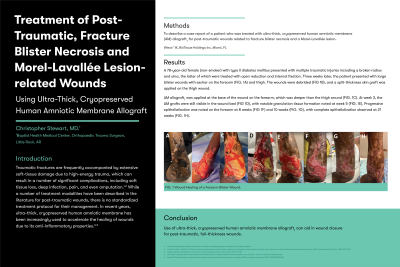Case Series/Study
(CS-134) Treatment of Post-Traumatic, Fracture Blister Necrosis and Morel-Lavallée Lesion-related Wounds Using Ultra-Thick, Cryopreserved Human Amniotic Membrane Allograft

Traumatic fractures are also frequently accompanied by extensive soft-tissue damage due to high-energy trauma, which can result in a number of significant complications, including soft tissue loss, deep infection, pain, and even amputation.1, 2 While a number of treatment modalities have been described in the literature for post-traumatic wounds, there is no standardized treatment protocol for their management. In recent years, use of ultra-thick, cryopreserved human amniotic membrane has been increasingly used to accelerate the healing of wounds due to its anti-inflammatory properties.3-5
Methods:
To describe a case report of a patient who was treated with ultra-thick, cryopreserved human amniotic membrane (AM) allograft† for post-traumatic wounds related to fracture blister necrosis and a Morel-Lavallée lesion.
Results:
A 78-year-old female (non-smoker) with type II diabetes mellitus presented with multiple traumatic injuries including a broken radius and ulna, the latter of which were treated with open reduction and internal fixation. Three weeks later, the patient presented with large blister wounds with eschar on the forearm and thigh. The wounds were debrided, and AM allograft† was applied at the base of the open wound. At week 3, the grafts were still visible in the wound bed with notable new granulation tissue formation. By 8 weeks, the base of the wounds were flush with the edges. A split-thickness skin graft was then applied on the thigh wound. Progressive epithelialization was noted. Complete epithelialization observed at 21 weeks.
Discussion: Use of ultra-thick, cryopreserved human amniotic membrane allograft† can aid in wound closure for post-traumatic, full-thickness wounds.
Trademarked Items:
References: 1. Tosounidis TH, Daskalakis II and Giannoudis PV. Fracture blisters: pathophysiology and management. Injury. 2020; 51: 2786-92.
2. Costa ML, Achten J, Knight R, et al. Effect of incisional negative pressure wound therapy vs standard wound dressing on deep surgical site infection after surgery for lower limb fractures associated with major trauma: the WHIST randomized clinical trial. Jama. 2020; 323: 519-26.
3. Tseng SC, Espana EM, Kawakita T, et al. How does amniotic membrane work? The ocular surface. 2004; 2: 177-87.
4. Fernandez D. Cryopreserved amniotic membrane and umbilical cord for a radiation-induced wound with exposed dura: a case report. Journal of wound care. 2019; 28: S4-s8.
5. Acevedo P. Successful treatment of painful chronic wounds with amniotic and umbilical cord tissue: A case series. SAGE open medical case reports. 2020; 8: 2050313X20910599.

.png)
